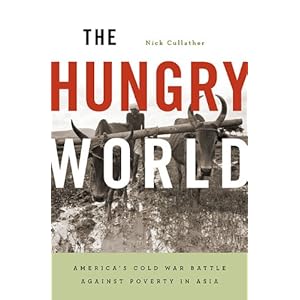Agricultural Instability Threatens Political, Economic Development

It is in the cities that the 2011 food crisis hits hardest. The revolution in Tunis began as a food riot. As markets in Cairo, Algiers, and Sanaa erupt, dictators are scrambling to buy off the opposition by lowering prices, but grain is scarce, and reports from the UN and the World Bank put the blame on overpopulation and climate.
Last year’s La Niña blighted harvests in Canada, Russia and the Ukraine, and the U.S. Department of Agriculture warns that an overcrowded earth is “putting unsustainable pressure on resources.” But in 2009, when weather was good, things were not that much better. Prices get high-level attention in the odd years when they are high, not in the typical years when they are typically abysmal.
2002, the index year against which the current disaster is measured, was the bottom of a steep 50-year decline in prices. Commodities were cheaper by half than they are now, and there was no world crisis, only local misery. Bankrupted peasants abandoned Chinese villages for urban slums. Twenty thousand Punjabi farmers committed suicide. Sugar workers clashed with police in Mexico, and Nebraska farmers took jobs at Wal-Mart to stave off foreclosure.
At last week’s Davos forum, French prime minister Nicolas Sarkozy and World Bank President Robert Zoellick urged stockpiles and “weather insurance or a rainfall index” as practical steps for dealing with nature’s limitations.
There may be another problem too, but it is hardly surprising that world leaders should overlook it. Since the 1950s, chronic underinvestment in agriculture has been considered a normal feature of a healthy, growing economy. For most of the twentieth century, a successful farm policy was one that delivered cheap food to urban consumers, whatever the cost at the producing end.
In the 1930s, German and Soviet planners first began to speak of an “agricultural sector,” a subordinate economy-within-the-economy whose profits could be diverted, by force if necessary, into industrial expansion. Émigré economists brought the concept to Washington, but Franklin Roosevelt initially went a different way.
New Dealers lifted food prices by creating artificial scarcities. In three years farm earnings rose to “parity” with 1916, the best year on record, and there they stayed. When the Supreme Court threw out the Agricultural Adjustment Act, policy shifted toward subsidies that held farm income steady while filling grocery shelves with low-cost staples. By the end of the 1930s, according to Rebecca West, all countries—communist, fascist, and capitalist—had accepted “the insane dispensation which pays the food-producer worst of all workers.”
Dual-economy theory soon entered the canon of development policy. Nobel economist W. Arthur Lewis realized in 1952 that the function of the rural sector was as a “reservoir of cheap labor” for the urban sector. Development models were built around the “zero value” doctrine, which held that non-industrial production had no measurable worth until liberated for use in manufacturing.
Newly independent regimes saw the potential. India’s five-year plans defined agriculture as “a bargain sector, which can produce the requisite surplus with relatively low investment and in a comparatively short time.” Taxes, price controls, duties and currency policies were subtly or overtly designed to siphon “waste” profits from rural producers. Enterprise was punished by anti-profiteering laws applied solely to the farm sector. Cheap food meant cheap labor, which gave emerging Asia its competitive edge. The Kennedy administration helped, depressing prices still further by flooding Asian markets with surplus wheat.
By 1965, India’s farmers had given up, and the country depended on an unsustainable 11 million tons of American grain. Policy had to change, and it did. The Green Revolution was hailed as the salvation of millions from drought and overpopulation, but it actually rescued Asia from its catastrophic disinvestment in agriculture. Dwarf wheat, Norman Borlaug explained, was only a “catalyst” for policies that returned resources to the countryside, especially price supports which gave peasants a rare chance to make a decent living.
Governments took the lesson and food production rose dramatically, but the 1980s debt crisis forced African and Latin American countries again to squeeze their rural sectors for cash. A neo-liberal consensus dismantled the remaining credit and subsidy programs, and when food prices spiked in the 1990s experts spoke soberly about climate and overpopulation.
Agriculture is a transparent, responsive sector, and quick profits fueled a production boom followed by the market collapse of 2002. The cycles have become sharper. The 2008 peak was followed by a 50 percent plunge in soy prices and then this year’s surge.
The price of onions in India is up 80 percent; South Korea and the Philippines face shortages of fish and powdered milk, and countries around the world are reaching for the standby solutions, cracking down on hoarders and adjusting quotas and duties to force down local food prices.
Last week the World Economic Forum, in an uneasy forecast, questioned whether farmers could meet the twin challenges of demography and climate. If history is any guide, they can, as they have in the past, but not unless they get paid. A recent poll shows half of India’s farmers want to quit. Many who till high-risk lands on which the expansion of the food supply depends have already given up and left the losing sector to seek a place in the winning one. There, like the mobs in Tunis, they can demand food, instead of having to grow it.
A lasting fix will require more than an adjustment to allow cultivators to survive. It will require unlearning a half century of dogma which relegates agriculture to a subordinate status. The global economy includes the global countryside, and the return of prosperity will have to begin there.